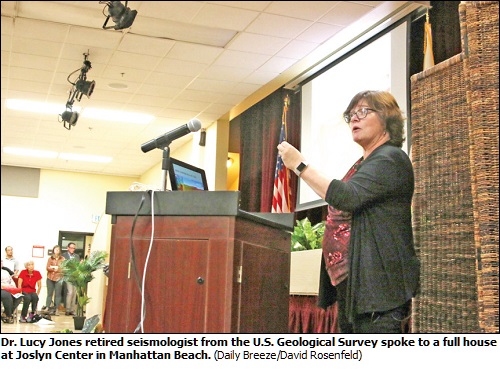
|
|

|
|
| April 26, 2024 |
|
Earthquake expert details the South Bay’s greatest threats from the ‘big one’ 
MANHATTAN BEACH--Leave it to Lucy Jones, Southern California’s go-to expert on all things earthquake, to find a positive sidelight to the normally devastating effects of major earth movement in such a populous region.
Speaking this week to a capacity crowd at the Joslyn Center in Manhattan Beach, the retired U.S. Geological Survey seismologist said Southern California can expect a decrease in population after the next major temblor. The only times Los Angeles has lost population, she said, was after major earthquakes in 1971 (Sylmar) and 1994 (Northridge). “People just said, ‘I don’t want to deal with that,’ ” Jones said. Aside from that interesting factoid, Jones talked primarily about the realities of the “big one” striking and how South Bay residents should prepare. When a magnitude 7.9 earthquake or greater rumbles along the San Andreas fault, an estimated 1,800 people in Southern California could die, roughly 53,000 people could be injured and 250,000 people likely will be homeless. “Compared to a person’s chances of being murdered or dying on the freeway, it’s not that big of a risk,” said Jones, who has a way of putting things in perspective. While the shaking and collapsing buildings pose an immediate safety threat, it’s the aftermath of a major earthquake that Jones said people should prepare themselves for the most. Roughly 1,500 buildings will collapse, but more than 300,000 structures will likely be severely damaged, which is why she called on every homeowner to have their residence inspected for seismic security and possible retrofits. Any home built before 1980 is potentially dangerous and homes built before 1997 should likely be retrofitted, she said. And there isn’t much time, she said. Paleoseismologists who analyze geologic formations to learn when earthquakes happened in the past say a major quake of 8.0 magnitude or greater has occurred in Southern California nearly every 150 years. It’s been 340 years since the last one. “We know we have a history of earthquakes. We know it’s been a really long time since the last one,” Jones said. “I’m not calling it overdue because that implies there is a regular time frame. Clearly, something can cause a long interval. That’s what’s happening right now. At some point our luck runs out.” Every major piece of infrastructure in the Los Angeles area needed to sustain life, electrical lines, telecommunication networks and water aqueducts, cross over the San Andreas fault line and would likely be severed in the event of a major earthquake, Jones said. It could be days or weeks before power and water delivery are restored, she predicted. Of the estimated 1,600 structure fires predicted, firefighters likely will not be able to get to all of them, which means many people just might have to fight those fires themselves. “We worry about earthquakes killing us, which we shouldn’t,” Jones said. “You are far more likely to be murdered in Southern California. However, we don’t worry sufficiently about the capacity of the earthquakes to bankrupt us and to destroy our community. You may live through this and decide you don’t want to stay. Everything a community does to come together is critical to how we get through this.” In the South Bay, the actual shaking from a San Andreas quake will likely not be as severe as elsewhere in the L.A. basin due to its distance from the fault line. However, soil liquefaction is a real threat that could damage infrastructure locally. As the earth shakes, soil is compressed like flour in a jar that’s tapped on a counter. Add water to the mix, and when the pressure of the water matches that of the soil, quicksand occurs, which can collapse sewer and water pipes. “When the 1933 earthquake hit, when sewers were broken, people dug latrines in their backyard,” Jones said. “With 20 million residents of Southern California, if we are all digging latrines in our backyard, we have a major public health problem.” The most important thing people can do to prepare for an earthquake is to know their neighbors, Jones said. A coordinated response effort locally will ensure a quicker recovery and greater level of safety. “Store water, get ready for the fires, do it with your family and do it with the community,” she said. Susan Goldstein, a Neighborhood Watch block captain in Manhattan Beach, said she attended Monday night’s event to help her neighbors prepare. “I would like to get more of our neighbors involved in getting to know each other and know what types of skills are out there, so we can act together when there are emergencies,” Goldstein said. Friedl Jalili said the presentation was both reassuring and frightening. “I’m going to have to go home and take a closer look at my house to see if it needs to be inspected because it’s old,” Jalili said. Sam Kelso said it was a great reminder to prepare an emergency survival kit. ‘I’ve always been slow to get my disaster kit together,” Kelso said. “We get the water and you drink it and don’t replace it.” (Source: The Daily Breeze) Story Date: November 14, 2017
|